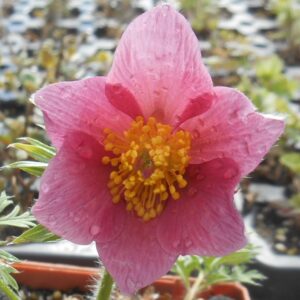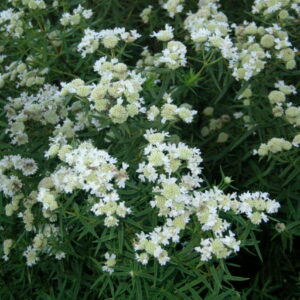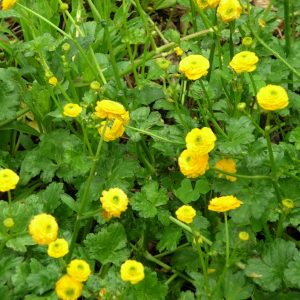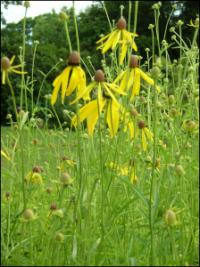Shop
Showing 601–608 of 778 results
-
Pulsatilla vulgaris var. rubra syn. Anemone pulsatilla var. rubra Pasqueflower
Wine-red petals of bell-shape with yellow centers flowers in early spring. Fun, furry foliage
OUT OF STOCK
Wine-red petals of bell-shape with yellow centers flowers in early spring. Fun, furry foliage and Medusa-like seed heads.
Size: 12-20” x 4-8”
Care: sun in well-drained to moist well-drained soil
Native: Europe
Wildlife Value: Deer resistant, early pollen source for bees.Called Pasqueflower because it blooms at Easter time. Variety rubra considered a separate species, not a variety, by Caspar Bauhin in Theatri botanici, 1671. Illustrated in Gerard’s Herball, 1636.
-
Punica granatum var. nana Dwarf pomegranate Z 7-11
Adorable dwarf shrub bearing orange-red blooms in July and August then tiny, edible pomegranates. Where not hardy makes good container plant and bonsai.
ARCHIVED
Note: This is a plant not currently for sale. This is an archive page preserved for informational use.
Adorable dwarf shrub bearing orange-red blooms in July and August then tiny, edible pomegranates. Where not hardy makes good container plant and bonsai.
Size: 2-4’ x 2-4’
Care: sun to part shade in moist well-drained to well-drained soil
Native: Europe to Himalayas“The plants will bear miniature fruit if grown in areas with year-round temperatures that rarely fall below 40° F. To grow indoors, moderate night-time temperatures should be given (50° to 60° F). Keep at 40° to 45° F in winter until new growth appears. In the growing period, keep moderately moist. Water sparingly from August on. This plant requires good drainage. Plants will bear fruit indoors if grown in a sunny exposure.” Issour Botanic Garden. It is deciduous and may lose its leaves.
This dwarf described in 1803. -
Pycanthemum muticum Clustered Mountain Mint, Blunt Mountain Mint Z 4-8
Silvery bracts underlying silvery-pink pincushion flowers blooming from June to September. Flowers and leaves minty fragrance.
OUT OF STOCK
Silvery bracts underlying silvery-pink pincushion flowers blooming from June to September. Flowers and leaves minty fragrance.
Size: 12-36” x 12-36” spreading.
Care: sun to part shade in moist to well-drained soil incl. drought
Native: Maine to Michigan, south and angling southwest from Illinois to Texas
Wildlife Value: Deer resistant. One of highest nectar and pollen producing flowers attracting copious numbers and kinds of bees, butterflies, wasps and other insects.
Awards: Georgia Native Plant Society Plant of the Year 2022Collected and described by French botanist André Michaux (1746-1802) who spent 11 years exploring the North America for plants. 1800.
-
Pycanthemum virginianum Mountain mint Z 4-8
Corymbs of numerous pinkish-white blossoms, leaves fragrant.
Corymbs of numerous pinkish-white blossoms in August, leaves fragrant.
Size: 3' x 18"
Care: full sun to part shade in moist well-drained to well-drained soil
Native: Wisconsin native, Eastern U.S.
Wildlife Value: attracts butterflies, supports over 50 bee species.Named by Linnaeus in 1753. Pycanthemum is Greek meaning “dense blossom.” Chippewa used it to stop menstrual flow, cure chills and fever and to season meat. The plant gave the Meskwaki energy and lured minks into their traps. Lakota Sioux: “The leaves make a very pleasant tea. An infusion of the plant is taken for coughs.” Grown at America’s 1st botanic garden, Elgin Botanic Garden 1811
-
Ranunculus acris ‘Flora-pleno’ Meadow buttercup Z 4-8 POISON
Scads of cheerful yellow balls made from many petals, bloom in early spring. Excellent cut flower
ARCHIVED
Note: This is a plant not currently for sale. This is an archive page preserved for informational use.
Scads of cheerful yellow balls made from many petals, bloom in early spring. Excellent cut flower
Size: 18-24” x 12” slowly spreading
Care: Sun to part sun in moist soil
Native: Europe
Wildlife Value: deer resistant, attract butterflies
Awards: Royal Horticultural Society Award of Garden MeritRanunculus is Latin for little frog, so named by Roman Pliny referring to the wet conditions required by some ranunculus. William Robinson considered this “pretty.” The English Flower Garden 1899.
-
Ranunculus repens var. pleniflorus Creeping buttercup Z 3-9
Small bright yellow nearly ball-shaped flowers May - June
Small bright yellow nearly ball-shaped flowers May – June
LIMITED QUANTITES AVAILABLE, LIMIT OF 1 PER CUSTOMER PLEASE
Size: 8-12" x 10" spreading
Care: Part sun to shade in moist soil
Native: Europe, Siberia, from Newfoundland to VirginiaRanunculus is Latin for little frog, so named by Pliny in Roman times referring to the wet conditions required by some ranunculus. In 1629 John Parkinson, apothecary to James I and royal botanist to Charles I, called this Ranunculus protensis flore multiplici. The root was supposed to break persistent sores by “drawing the venome to the place.” Jefferson planted Creeping buttercup at Monticello in 1782; it may or may not have been this double.
-
Ratibida pinnata Prairie coneflower Z 3-8
Skirt of drooping, sunny, thin petals surround erect brown cone on this fragrant flower, smelling of anise, June-August.
Skirt of drooping, sunny, thin petals surround erect brown cone on this fragrant flower, smelling of anise, June-August.
Size: 4' x 18"
Care: sun to part shade in any soil
Native: Ontario, VT to FL, SD to OK, incl. Wisconsin
Wildlife Value: Butterfly plant. Birds eat seeds.Pinnata means “feathery” in Latin referring to the thin petals of the flower. 1st Americans cured toothaches with the root & made tea from the cone and leaves. Collected by French explorer Michaux on the prairies of Illinois in 1795.
-
Rheum palmatum var. tanguticum Ornamental rhubarb Z 4-8
Gigantic, jagged-edge, bronze-tinted turning green foliage with pink plumes reaching skyward atop tall stalks in early summer.
OUT OF STOCK
Gigantic, jagged-edge, bronze-tinted turning green foliage with pink plumes reaching skyward atop tall stalks in early summer.
Size: 8' x 6'
Care: Sun to part shade, moist well-drained fertile soil, mulch in spring
Native: valleys of Gansu, Qinghai, Shaanxi, Xizang, ChinaRhubarb carried from its native China to central Asia and then to Europe by caravans more than 2000 years ago. Both Dioscorides and Pliny mentioned the plant during the 1st century A.D. In 1300’s Marco Polo explained that merchants of China do not take beasts of burden into the mountains where rhubarb grows because “if eaten by them, has the effect of causing the hoofs of the animal to drop off.” This variety 1st described in 1874






